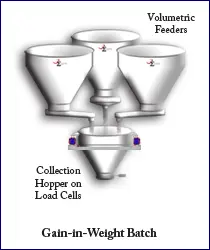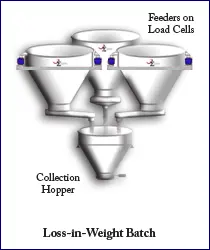Methods of Material Feeding
Batch Feeders deliver materials or ingredients in “batches” from a group of feeders into a collection hopper, usually used to manufacture blended products. Our feeders focus on accuracy and speed of batch.
Feeding Type | Description of Process |
| Loss-in-Weight feeders with load cells simultaneously dispense their material or ingredient into a central collection hopper. |
| Volumetric feeders, each containing a specific material or ingredient, dispense their material in sequence into a collection hopper, which is mounted on a scale or load cells. |
Feeder Type | Benefits |
| Loss-in-Weight batching is ideal for batching micro and minor ingredients where accuracy is vital. It is the fastest and most accurate system to feed individual ingredients simultaneously into a batch process |
| Gain-in-Weight batching is ideal for batching major ingredients where accuracy is a little bit more flexible. Gain-in-Weight batching systems are more economical when high accuracy is not a major need. |
METHODS OF BATCH FEEDING
Batch feeding is typically used to manufacture blended products that involves feeding individual ingredients or materials based upon their weight percentage in a blend. Ingredients are categorized as majors, minors and micros, depending on their weight percentage. Two types of feeding are used for batch feeding: Gain-in-Weight and Loss-in-Weight feeding.
A Gain-in-Weight (GIW) batching system is usually used to batch major ingredients. This type of feeding station features volumetric feeding equipment, such as screw feeders, vibratory feeders, or valves that feed the material (based on motor output) to a hopper on load cells.
The Loss-in-Weight (LIW) batching system is usually used to batch micro and minor ingredients. This type of feeding features gravimetric feeding equipment, such as loss-in-weight screw or vibratory feeders, which are mounted on individual load cells or scales.

Gain-in-Weight Batching
Volumetric feeders are often used in GIW applications for controlled batch feeding and dry bulk materials. In some applications, the material is batched directly into IBCs (Intermediate Bulk Containers), hoppers or drums. Other times, material is batched into industrial blenders.
GIW batching involves volumetric feeders dispensing multiple ingredients in sequence into a collection hopper mounted on load cells. In most cases, the volumetric feeder dispenses approximately 90% of the batch at high speed, slowing down towards the end of the batch to dispense the last 10% at a reduced rate. Our feeders feature a “dribble mode” in order to ensure higher accuracy.
A controller monitors the amount of each ingredient being fed, and signals each volumetric feeder to start, increase or reduce speed, or stop according to the target batch amount. When all of the materials have been fed in their appropriate amounts, the batch is successfully complete.

Loss-in-Weight Batching
If individual ingredients must be weighed and fed more accurately, then a LIW batching system is used. Another criteria that requires a LIW batching system is when batch cycle times must be very short. In this form of batching, gravimetric feeders simultaneously feed multiple ingredients into a collection hopper. The LIW controller “controls” the amount of material being dispensed by sending a signal to the motor depending on the current feed rate that the controller reads.
Since each feeder has a set of load cells, this method of batching produces highly accurate batches for each ingredient. When all of the materials have been fed in their appropriate amounts, the batch is successfully complete. This method is very valuable if the application involves expensive materials that can be saved by carefully weighing and feeding through the LIW controller. This form of batching meters all of the ingredients into the collection hopper at the same time, eliminating the layering effect (as seen in GIW batching) and the time and cost for further processing.
Continuous Feeding
Continuous material feeders deliver materials or ingredients from a feeder into a continuous process, usually designed to operate 24/7, except during maintenance. This can involve volumetric or gravimetric feeding.
Continuous Feeding | |||
Feeding Type | Description of Process | Feeder Type | Benefits |
| Volumetric feeders are open-loop devices, where the feed rate is a function of constant vibrator motor speed and is not governed by any ongoing data feedback from the operation. |
| Volumetric feeders are used when the bulk density of the material fed is consistent or where feeder accuracy is not a major need. |
| Gravimetric feeders capture and document moment-by-moment feeder performance during continuous process operations, |
| Gravimetric feeders provide precise feed rates and an immediate alert if there is any interruption of material flow. |
Volumetric or gravimetric feeders are used to deliver bulk solids into a continuous process. Whether you use gravimetric or volumetric feeders depends on the materials and application. Volumetric feeders are simpler in design and typically more cost effective than gravimetric feeders, but a volumetric feeder is essentially an open-loop device, meaning that the feed rate is solely a function of feeder speed and isn’t governed by any ongoing data feedback from the operation. Since a material’s bulk density can vary over time, the actual amount of material delivered to the process (the mass flow) can vary as well. Also, it’s possible for a volumetric feeder to have little or no material discharging while the feeder is running with no way of detecting the error. Even using level sensors in the feed hopper may not alert the process of this condition in a timely fashion, and off-spec product may result for a period of time. This makes volumetric feeders inappropriate for many continuous processes that have rigorous accuracy requirements.
Volumetric feeders are best suited for applications handling materials whose bulk density doesn’t vary significantly and processes for which high feeder accuracy isn’t critical and direct measurement of the discharged material isn’t required. For continuous processes where the ingredient amounts are critical to product quality, gravimetric feeding is the best method. Gravimetric feeders continuously measure the material’s mass flow and adjust the feedrate to maintain the desired setpoint. The two leading gravimetric feeding methods used in continuous processes are LIW feeding and weighbelt feeding.
Loss-in-Weight Continuous Feeding
LIW feeders are highly accurate, directly measure and control a wide range of material feedrates, and can fully contain the material and dust within the confines of the feeder. For continuous LIW feeding, the way material is refilled in the feeder can be almost as critical as the feeder type itself. The objective is to refill the feeder as quickly as possible to avoid interrupting the feeding process, so pneumatic receivers, which operate under a dilute-phase, vacuum-transfer principle, are often used as refill devices in a process called vacuum sequencing.
The dry material feeder is the most critical component in any continuous loss-in-weight system. The feeder must be able to provide a uniform bulk density product, without bridging, ratholing, or funnel flow. Without proper control of the bulk product, the system is marginal at best. Therefore it is critical to match the correct feeding device to each of your products in meeting your goals. An accurate and dependable LIW system is comprised of four major components: the Feeder, the Scale, the LIW Controller, and the Refill Device.
Continuous weighbelt feeding.A weighbelt feeder is useful for continuous applications that require a gravimetric feeder but don’t have adequate headspace to support a traditional hopper and LIW feeder system. Similarly, a weighbelt feeder can provide greater operational flexibility, because the feedrate can be adjusted by altering the existing material-bed geometry or belt speed. By comparison, most continuous LIW feeding systems require an increase in physical size to accommodate increased flow rates.
Email us at info@cmtnc.com or Fill Out the Contact Form Below

